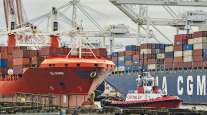Managing Editor, Features and Multimedia
Firms Leverage Innovations to Manage Supply Chain Disruptions

[Stay on top of transportation news: Get TTNews in your inbox.]
CHICAGO — Trucking and logistics leaders said their companies’ investments in technology and more flexible service offerings have paid dividends during the supply chain turbulence of the past few years.
The seemingly endless string of disruptions since the onset of the coronavirus pandemic has highlighted the value of innovation, executives said at Reuters Events’ Supply Chain Execution USA 2022 conference June 1-2.
ArcBest CEO Judy McReynolds said shippers are facing a longer list of supply chain challenges than at any other point in her career. Those pain points include steep competition for labor and lingering supply and capacity challenges, along with newer issues such as inflation, soaring fuel prices, the war in Ukraine and now the reopening of ports in China following the most recent wave of coronavirus-related lockdowns in that country.

ArcBest CEO Judy McReynolds discusses the company’s acquisitions and technology investments at Reuters Events’ Supply Chain Execution USA 2022 conference. (Seth Clevenger/Transport Topics)
“I’ve never seen a list like that,” McReynolds said. “I’ve never heard so many challenges.”
McReynolds said ArcBest has been able to help its customers navigate those disruptions due in large part to its technology investments and acquisitions in the years prior to the pandemic.
Guided by input from its customers, the less-than-truckload carrier and logistics provider has completed five acquisitions since 2012 to better address the evolving needs of its shipper base. The company’s most recent acquisition was MoLo Solutions, a large truckload freight broker based in Chicago.
“We’ve been on a journey to really better position ourselves with assets and capacity resources so we can be responsive,” McReynolds said.
ArcBest also has taken steps to more closely integrate its various service offerings to increase flexibility and enhance its ability to not only plan, but also react when the need arises. McReynolds cited a case where ArcBest worked with a fitness equipment company to help shift its imports to the East Coast to help avoid delays caused by port congestion on the West Coast in 2021.
Without its recent acquisitions, technology investments and integrations, “we wouldn’t have been as prepared for these events,” McReynolds said. “It was because we listened, we thought ahead, and we made those investments.”
ArcBest, based in Fort Smith, Ark., ranks No. 15 on the Transport Topics Top 100 list of the largest for-hire carriers in North America.
Another big name in transportation and logistics, J.B Hunt Transport Services, has been investing heavily in technology to help customers move their freight more efficiently.

J.B. Hunt’s Eric McGee described the company’s continued investments in its J.B. Hunt 360 technology platform. (Seth Clevenger/Transport Topics)
Eric McGee, executive vice president of highway services, cited the launch of the company’s J.B. Hunt 360 freight marketplace in 2017 and the expansion of that technology platform during the past five years.
The primary goals, he said, have been to improve shippers’ access to capacity, provide more visibility into the status of their shipments and offer greater transparency through better use of data.
“We have a lot of data,” he said. “It’s really what we do with it.”
The industry stands to gain if more carriers, brokers and shippers “let [their] guard down some” and find ways to share more information, McGee said.
“No one should be too prideful to think they have all the answers,” he said.
Moving forward, J.B. Hunt will partner with other transportation companies and other technology platforms to advance its push for greater efficiency.
“We say we are endeavoring to build the most efficient transportation network in North America. That’s not going to be built by J.B. Hunt alone,” he said.
J.B. Hunt, based in Lowell, Ark., ranks No. 4 on the TT Top 100 list of for-hire carriers.
DHL Supply Chain, the contract logistics division of Deutsche Post DHL, has embraced digitization and automation to help meet rising demand and better support its workforce.
“Investing in innovation does take an all-in strategy. We’ve learned that at DHL. It’s technology and talent,” said Sally Miller, chief information officer for North America at DHL Supply Chain.
The continued growth of e-commerce has driven a trend toward more frequent, smaller shipments and returns, which in turn has created a need for more labor in the logistics sector, she said.
To help address that need, DHL has invested in various forms of warehouse automation.
Want more news? Listen to today's daily briefing above or go here for more info
One example is collaborative warehouse robots, or “co-bots.” DHL has deployed more than 2,000 of these co-bots, which assist its warehouse workers in picking operations.
“This is a solution that really helps us with the shortage of labor, especially during peak periods where we have to flex up and down,” Miller said.
Other examples include robotic arms to unload cartons and autonomous forklifts.
“The evolution of these solutions has really saved us, especially last year during peak,” she said.
At the same time, DHL is investing in data analytics to help improve processes and optimize labor and forecasting.
DHL Supply Chain ranks No. 12 on TT’s Top 100 list of the largest logistics providers in North America.




